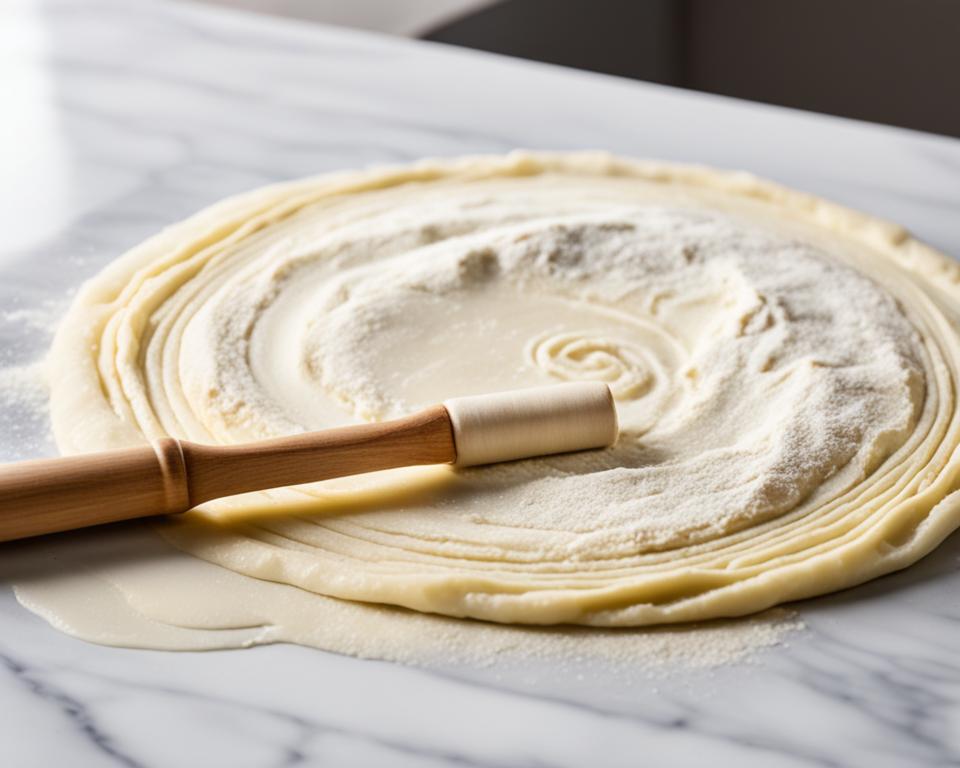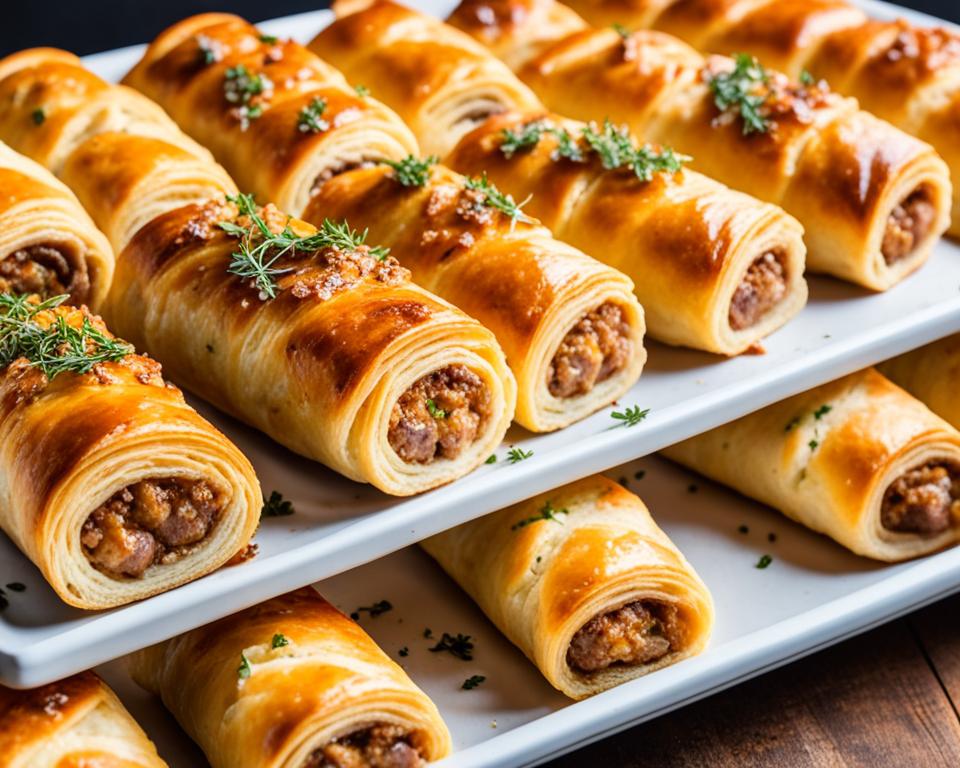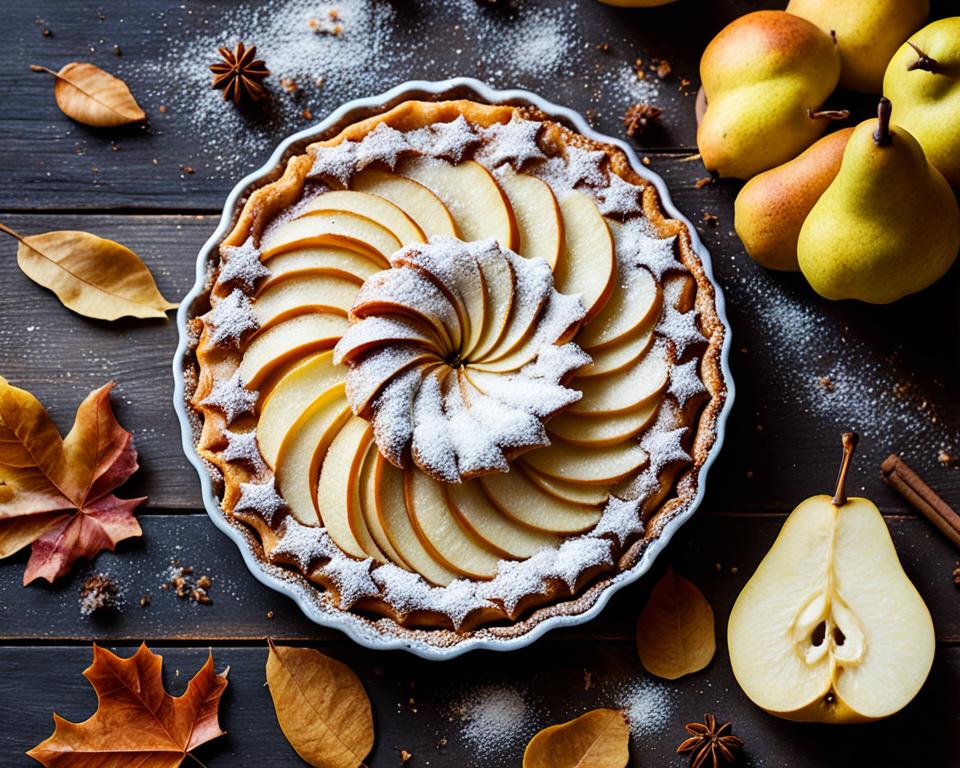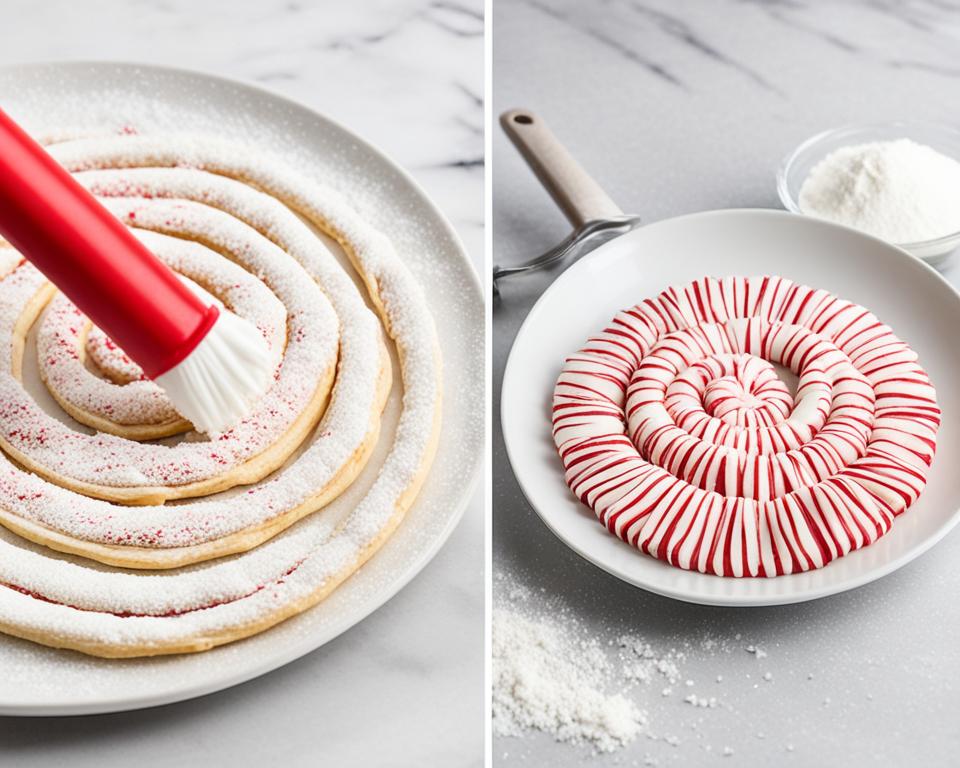Step into the world of baking where homemade pastry reigns supreme and pre-made store purchases simply fall short. For those intimidated by the prospect of making Flaky Layered Pastry from scratch, the secret lies in understanding simple recipe secrets and embracing a handful of essential baking tips. As any pastry chef will attest, the difference between a passable pie crust and an impressively light, crispy pastry is often found in the subtleties of technique and the purity of the ingredients used.
Creating a delightful homemade pastry doesn’t have to involve complex steps or obscure knowledge. With straightforward guidance and an appreciation for the craft, one can weave together the tender layers that hallmark exceptional pastry. What’s more, doing so imparts not only delicious results but a profound sense of accomplishment.
Key Takeaways
- Mastering homemade pastry can elevate your baking game, leaving pre-made alternatives behind.
- Achieving flaky perfection is more accessible than one might think, with the right techniques at hand.
- The foundation of flaky pastry begins with simple, yet precise recipe secrets.
- Two non-negotiable conditions for successful pastry making include cool environments and a well-heated oven.
- Using quality ingredients and following a few key steps can lead to impressively light and flaky layered pastry that’s sure to impress.
The Art of Making Flaky Layered Pastry
The journey through the art of baking leads us to the pinnacle of pastry perfection: the flaky layered pastry. This confectionery marvel, with its ethereal layers and rich, airy texture, is the embodiment of skillful pastry techniques and the meticulous application of time-honored methods. Crafting such a masterpiece is not merely a process; it’s an artistic expression, representative of both a baker’s finesse and their dedication to the craft.
At the heart of creating the perfect pastry texture is the delicate process of incorporating cold fat into dough, an essential step that separates the novice from the maestro. The objective is to create a pastry that, upon entering a well-heated oven, experiences the transformational power of heat: fat melts, trapped air expands, and the pastry rises to develop those signature flaky, light layers.
The result of this process—a golden, buttery, flaky layered pastry—captures the essence of the art of baking. It’s a testament to the baker’s ability to transmute humble ingredients into an exquisite, layered creation. In following this artistic path, bakers arouse the senses and offer a glimpse into the sublime realm of baking, where attention to detail and respect for ingredients reign supreme.
- To achieve flakiness, the fat used must be cold and tactfully layered within the dough.
- A precise balance between temperature and handling is crucial for the air to expand and create the pastry’s layers during baking.
- Mastering a flaky layered pastry is not only about following a recipe—it’s about understanding and feeling the dough’s needs.
In this pursuit of flaky excellence, let us not forget that baking is as much science as it is an art, requiring both an analytical eye and a creative touch. The pastry techniques shared here serve as a guide, empowering you to venture into the kitchen and unveil the beauty nestled within flour, butter, and water. Embrace each step with patience and passion, and you shall be rewarded with pastries that embody the very soul of baking—the incomparable, flaky layered pastry.
Choosing the Right Ingredients for Your Pastry
Embarking on the delightful journey of pastry-making begins with a careful selection of pastry ingredients. The choices made at this initial stage set the foundation for the texture, flavor, and overall quality of the final product. Understanding the role each ingredient plays in creating the perfect pastry dough consistency is a skill that separates good bakers from great ones.
Butter at Room Temperature: A Key Factor
The mastery of flaky pastry starts with room temperature butter. The ideal room temperature butter is neither too hard nor too soft but has just the right consistency for easy blending into the flour. It is paramount for achieving the sought-after layered effect in pastry, as it spreads uniformly, ensuring that each layer of dough has an equal chance to rise and create that desirable flakiness.
The Importance of Using Cold Water in Pastry Dough
Conversely, when it comes to adding moisture to the pastry, cold water is the secret ingredient. The shock of cold water helps maintain the integrity of the butter by preventing premature softening. This technique ensures that the butter remains distinct within the dough, melting only when it hits the heated oven, thereby contributing to the well-defined flaky layers that are key to a sublime pastry experience.
In essence, precise temperature control of ingredients like butter and water is instrumental to the pastry dough consistency. By adhering to these guidelines, bakers can all but guarantee their pathway to creating flaky, buttery pastries that are both visually impressive and irresistibly delicious.
Understanding the Laminating Process
The making of sublime layered pastry stands on a foundational technique known to professional and home bakers alike – the laminating process. This method, crucial for achieving the airy, light texture known in high-end patisseries involves a dance of dough and fat that are meticulously brought together through a series of motions, each calculated to maintain the integrity of pastry layers.
At the cornerstone of this process lies a variable that can make or break the outcome – temperature. Too warm, and the butter layers meld into the dough, leaving a heavy, greasy result. Too cold, and the dough cracks, losing that potential for the delicate rise. Here, we delve into the essential steps and considerations that ensure every roll, fold, and turn contributes to the creation of pastries boasting the perfect layered pastry texture.
Creating Perfect Layers with Butter
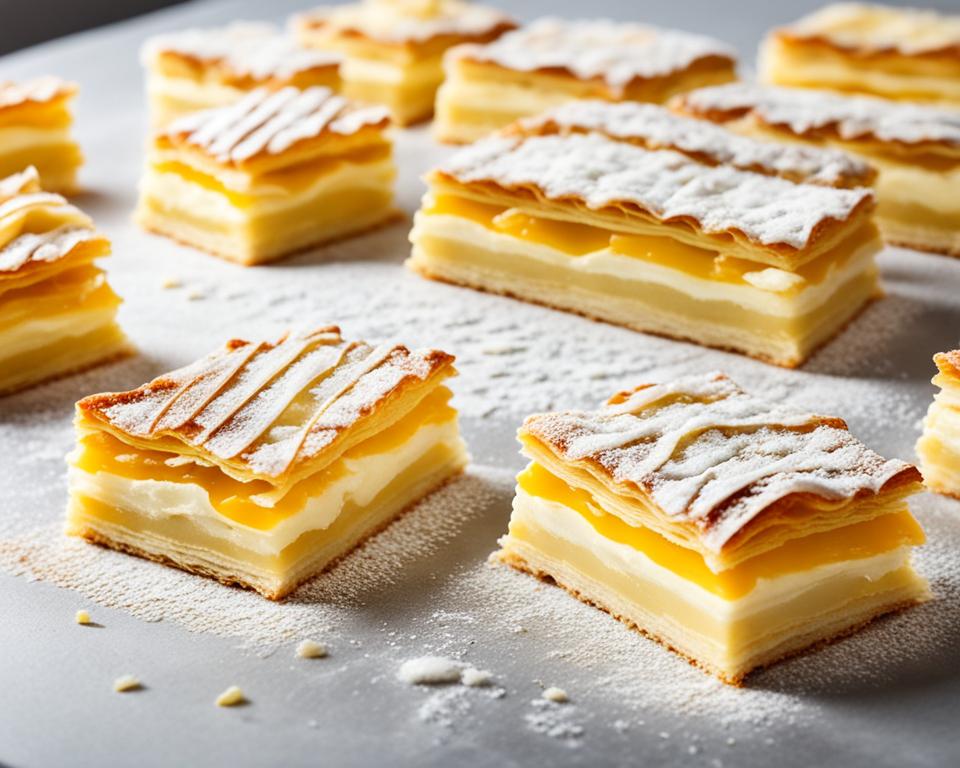
To initiate the layering, small dollops or thin sheets of cold, yet pliable butter are interspersed across the dough’s surface. This begins the formation of separate layers that, when exposed to the oven’s heat, will expand and separate into the flaky sheets we aim for. Precision in butter placement is key, and thorough but gentle butter incorporation ensures an even distribution throughout the pastry.
Rolling and Folding: Techniques for Ideal Lamination
Rolling and folding dough might appear straightforward, yet it is here where most of the flakiness factor is defined. After butter is added, the dough is rolled into a rectangle and then folded in thirds. This is akin to folding a letter, with one section over the next – a step best performed with a light touch to avoid compressing the layers. The dough is then turned 90 degrees, and the process begins anew.
Through repeated rolling and folding, layer upon layer is built up, with the butter creating a barrier that, in the oven, turns to steam and puffs up the pastry. A measured approach to this sequence is crucial to the laminating process, ensuring the dough remains cool and the butter does not soften excessively. Only this perfect synthesis of technique and temperature control can lead to the desired airy, layered pastry texture that is both visually stunning and satisfying to the palate.
Flaky Layered Pastry
The ultimate goal for any baker is to master the craft of creating the perfect Flaky Layered Pastry. Such mastery is characterized by a light and flaky texture that excites the taste buds and delights the senses in every bite. Yet, achieving this culinary badge of honor is not the result of an accidental mix of flour and butter. It involves a methodical approach, combining artisanal instincts with tried-and-true pastry tips.
To achieve those well-defined, crisp layers, bakers must strike an intricate balance between the temperature of the ingredients and the handling of the dough. When the conditions align, the pastry emerges with a texture so flaky and appearance so golden brown that it becomes the mark of perfect pastry craftsmanship.
There are numerous tips and techniques that can influence the outcome of your pastry endeavors. Here are a few pastry tips to keep in mind:
- Working in a cool environment prevents the butter from softening too early, maintaining distinct layers within your dough.
- A rolling pin is more than just a tool—it’s your partner in applying even pressure, crucial for a smooth, even expansion of layers.
- Resting is not just for the weary; your dough needs it too! Proper chilling helps in retaining those delicate layers, ensuring that your effort in lamination doesn’t go to waste.
| Ingredient Temperature | Technique | Outcome |
|---|---|---|
| Cold butter | Gentle folding and rolling | Layer separation for flakiness |
| Chilled water | Minimal handling | Prevention of gluten overdevelopment |
| Room temperature dough | Proper resting period | Optimal dough expansion and flakiness |
Remember, the path to creating a Flaky Layered Pastry is both an art and a science. By honoring the process and refining your techniques, you will transcend from a basic baker to a confident creator of that light and flaky texture that defines the quintessence of fine pastry.
Step-by-Step Guide to Quick and Easy Flaky Pastry
Embarking on the quest to create the ultimate flaky layered pastry begins with a commitment to quality and precise execution. This step-by-step guide offers an accessible path to crafting an extraordinary pastry, inviting both newcomers and seasoned bakers to achieve success. With a few key baking tips, the dream of a perfect pastry crust becomes an attainable reality.
Preparation: The Foundation of Great Pastry
Every great pastry starts with preparation. Assembling your ingredients before beginning the process not only saves time but also ensures that each element is measured and at the proper temperature. In this phase, bakers will also encounter the quick and easy recipe details of combining sieved flour with salt, introducing room-temperature butter, and the art of gradually adding cold water to achieve an elastic dough.
Baking Tips: Achieving the Perfect Crust
Beyond preparing your ingredients, there are crucial baking tips that pave the way for a flaky layered pastry. These tips include maintaining a cool environment to prevent the butter from softening and ensuring that your oven reaches the correct temperature before baking. Such practices contribute to a texture that is both flaky and tender.
| Step | Ingredient | Technique | Expected Outcome |
|---|---|---|---|
| 1 | Butter | Room-Temperature Integration | Evenly Incorporates for Layered Texture |
| 2 | Flour & Salt | Sieved Together | A Fine Mixture for a Smooth Base |
| 3 | Cold Water | Gradual Addition | Elastic Dough Formation |
| 4 | All Ingredients | Lamination by Folding & Rolling | Distinct, Crisp Pastry Layers |
| 5 | Dough | Chill in Refrigerator | Firm and Pliable Consistency for Baking |
By adhering to this guide, bakers will navigate the intricacies of making a flaky layered pastry with confidence. The step-by-step guide ensures that the process is not only rewarding but also yields a quick and easy recipe that stands as a testament to your baking prowess. Let these insights into the process encourage you to roll up your sleeves and create the impeccable perfect pastry crust you aspire to.
Adapting Pastry Recipes for Different Dishes
The realm of pastry recipes is as diverse as it is delicious, offering an array of options from the sweet enchantment of desserts to the savory satisfaction of main dishes. Versatile pastry is the foundation that allows culinary artists to weave together disparate ingredients into a comforting, unified whole. It’s about adapting recipes to fit the context of the meal, whether tweaking a base recipe to create luscious fruit fillings or enriching it for a hearty meat pie. By adapting recipes, chefs and home cooks alike unlock a treasure trove of different pastry dishes that cater to any and every palate.
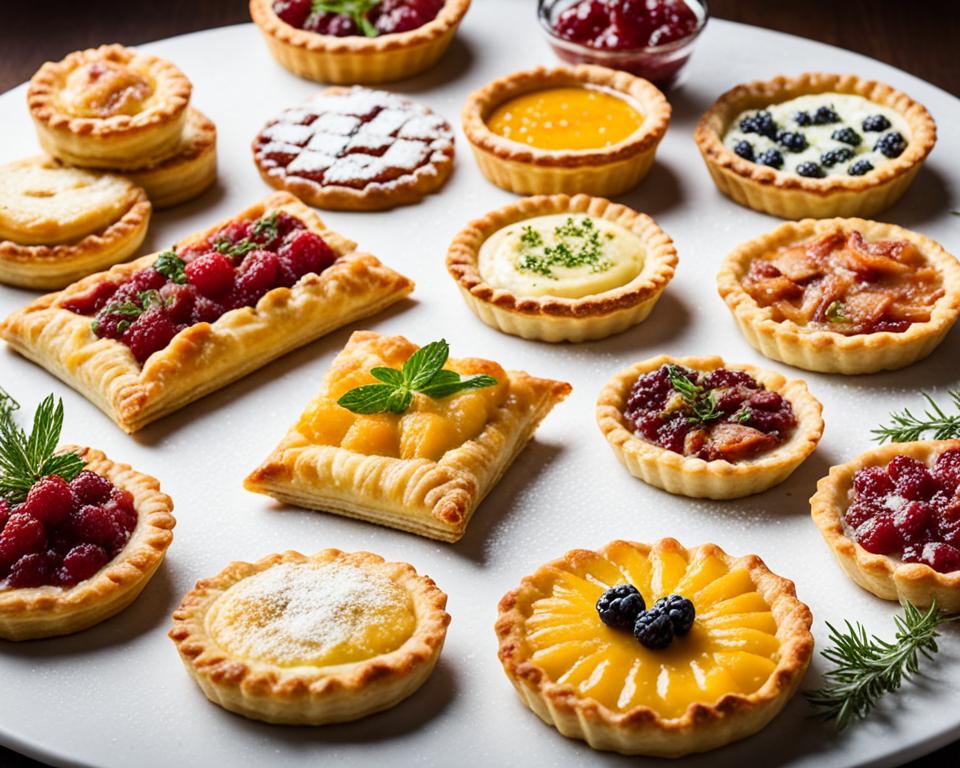
Let’s dive deeper into the world of pastry and discover methods for adapting pastry recipes to various culinary creations. Here are some tailored approaches that showcase the flexibility and innovation present in pastry work:
- Turning puff pastry into savory appetizers by adding herbs and cheese
- Folding delicate layers of pastry around sweetened fruit mixtures for summery tarts
- Modifying the sugar content when transitioning from sweet to savory applications
Each adaptation requires careful consideration of the end goal – a pastry that complements its filling and elevates the overall dish. The key is in understanding how changes to the recipe will affect the flakiness and flavor profile of the pastry.
| Pastry Dish Type | Adaptation for Sweet | Adaptation for Savory |
|---|---|---|
| Turnovers | Add vanilla extract and a sprinkle of sugar | Include a pinch of sea salt and finely chopped herbs |
| Strudels | Mix in cinnamon and a dollop of honey | Introduce savory spices and a layer of mustard |
| Savoury Pies | Incorporate fruit chutneys or sweet glazes | Use a variety of cheeses and/or cured meats |
Ultimately, the joy of pastry recipes lies in their boundless potential for customization. By blending classic techniques with personal flair, you can craft versatile pastries that are perfectly paired to any dish, be it a simple breakfast quiche or an elegant evening dessert. The process of adapting recipes is not just about the food—it’s an exploration of comfort, creativity, and the art of baking.
The Science Behind Pastry Layers
In the realm of pastry science, the allure of a perfectly layered pastry is akin to the quest for the Holy Grail among bakers. With its roots deeply embedded in the principles of baking chemistry, the art of creating pastry layers is much more than a culinary craft—it is, essentially, a scientific endeavor. Central to this delicate artistry is the process of lamination, a phenomenon that converts humble ingredients into majestic, textural wonders.
When dissecting the elements of successful pastry layers, one cannot overlook the role of temperature—both of the surroundings and ingredients. Herein lies the basis of lamination science, where cold chunks of butter are intertwined within the dough, only to be metamorphosed into steam within the high heat of an oven. This emergence of steam from the butter’s water content is what lifts and separates the dough, giving birth to the flaky layers that are immensely satisfying to both the palate and the eye.
In this transformative process, the technique is just as crucial as the controlled conditions. The approach to folding dough around layers of fat and the subsequent rolling reflect the precision of a scientist in a laboratory. Indeed, we can view the kitchen as a lab, where bakers apply the science of pastry to engineer an exquisite balance of taste and texture. The resulting pastry is not just food, but a manifestation of scientific principles in harmony with culinary art.
| Factor | Role in Lamination | Impact on Pastry Layers |
|---|---|---|
| Butter’s Water Content | Turns to steam, expands between dough | Creates flaky separation |
| Temperature Control | Preserves integrity of butter within dough | Ensures proper rise and texture |
| Folding and Rolling Technique | Distributes fat, forms multiple layers | Builds structure for flakiness upon baking |
The pastry’s rise to stardom is thus not a casual affair; it is a testimony to the intricate baking chemistry at play. Like alchemists of old, bakers transform basic materials into gold—golden layers, to be precise. Through the disciplined application of temperature, technique, and time, they create pastry layers that are as appealing to the senses as they are rooted in the steadfast laws of science.
Rolling Techniques for Perfect Thickness
Mastering the art of rolling is essential when striving for that flaky layered pastry that is both delicate and decadent. Whether you’re a seasoned baker or a curious novice, understanding the nuances of rolling techniques will elevate your baking to new heights. The way you handle and roll your dough directly affects the pastry thickness, and by extension, the overall quality of your baked goods. Let’s delve into the best practices for handling dough and the importance of utilizing the correct baking tools for rolling out your pastry.
Handling Dough: Avoiding Overworking
When it comes to handling dough, less is often more. Excessive handling can lead to overworked dough, which inevitably compromises the lightness and flakiness of the pastry. The key is to maintain a delicate balance – enough to integrate the components, but not so much as to develop an overly elastic gluten network. A gentle touch allows the rolling techniques to unfold the dough into the desired thickness without crushing the layers of fat that result in that much-coveted flaky texture upon baking.
Using the Right Tools for Rolling Pastry Dough
Just as a painter relies on their brush to create a masterpiece, a baker needs the proper baking tools to craft the perfect pastry. One such indispensable tool is the rolling pin. The ideal rolling pin will give you the control needed to roll out dough uniformly, thus ensuring even pastry thickness throughout. A lightly floured working surface is also paramount to rolling pastry, preventing the dough from sticking and tearing – a common obstacle on the path to pastry excellence.
| Baking Tool | Function | Benefit |
|---|---|---|
| Rolling Pin | Evenly flattens dough | Consistent thickness and texture |
| Pastry Mat | Provides non-stick surface | Cleaner work area and easier cleanup |
| Dough Scraper | Smoothly lifts and turns dough | Keeps dough intact/Reduces the risk of overworking |
| Bench Brush | Cleans flour from work surface and dough | Prevents dough from becoming too dry |
Through careful attention to rolling practices and the judicious use of baking tools, bakers can achieve the ideal pastry thickness that is the hallmark of truly artisanal pastries. Embrace these techniques next time you find yourself in the kitchen, and watch as the magic of flaky layers effortlessly unfolds beneath your rolling pin.
Chilling and Resting Your Dough: Why It’s Crucial
The process of chilling dough and resting dough plays an essential role in the art of creating that perfect flaky layered pastry. It’s not just a mere pause in the baking process but a critical phase that affects the dough consistency and the overall quality of the pastry. Whether you’re a seasoned baker or just beginning to explore the realm of homemade desserts, understanding the temperature impact and timing chills is fundamental to ensure maximum flakiness in each bite.
The Impact of Temperature on Dough Consistency
Why does temperature play such a pivotal role? The answer lies in the behavior of fat and gluten within the dough. Fat, such as butter, when kept cold, remains solid, creating layers within the pastry that steam and expand upon baking. Gluten, on the other hand, needs relaxation to prevent the dough from becoming tough. Correctly chilling dough stabilizes fat and softens gluten to achieve the desired dough consistency which will bake into beautifully separated, airy layers.
Timing Your Chills: Ensuring Maximum Flakiness
Chilling is not a one-time affair; it’s about the process and, importantly, the timing chills at various stages. Rushing can result in a pastry that’s hard to handle and lacks that mouth-watering flakiness. The key is patience; allowing your dough to rest in cooler temperatures helps the fat to firm up without becoming too hard, assuring maximum flakiness and a final product that boasts a superior taste and texture.
| Chilling Stage | Purpose | Duration |
|---|---|---|
| Initial Chill | To relax gluten and firm up fat | 30 to 60 minutes |
| Between Folds | To maintain dough temperature | 15 to 30 minutes |
| Pre-Baking | For final firmness and pliability | 20 to 30 minutes |
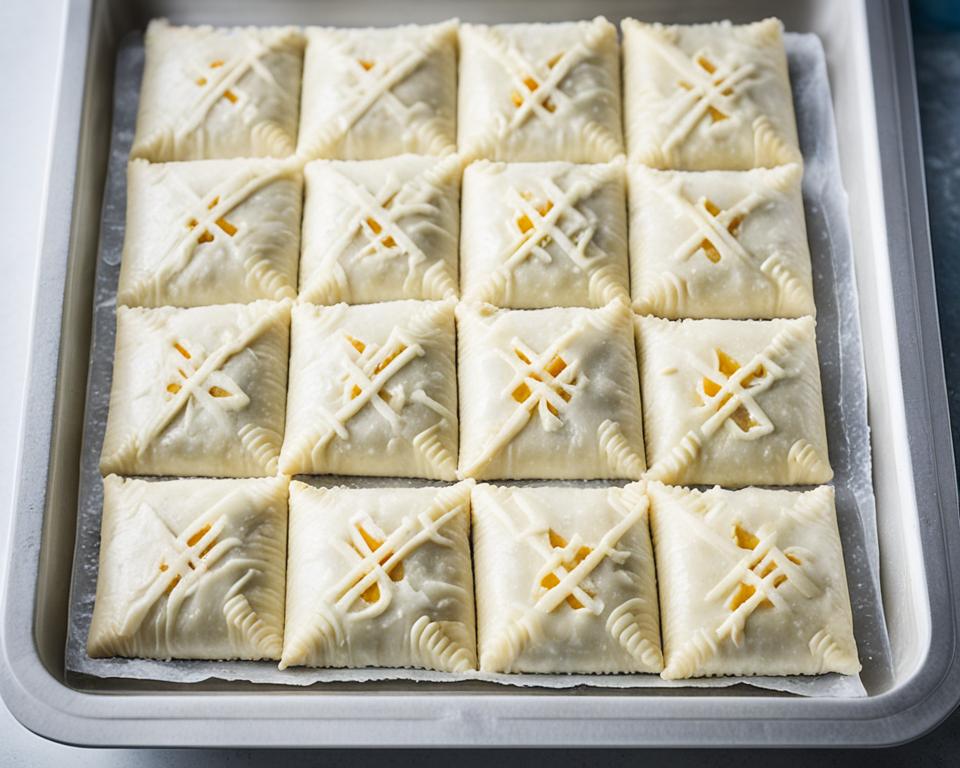
How to Customize Your Pastry for Sweet or Savory Creations
Unlocking the potential of customize pastry techniques allows bakers to transform simple dough into a wide array of delightful sweet pastry dishes and savory pastry creations. By adjusting key ingredients and introducing new flavors, personalizing each batch becomes an enjoyable endeavor in culinary versatility. Let’s explore how to adeptly customize your pastry, ensuring that whether you’re crafting a sugary treat or a hearty meal, your pastries are tailored to any occasion.
Pastry customization invites one to think beyond the conventional, urging a blend of creativity with classic methods. The choices you make in flavoring, from the spices you select to the fillings you concoct, can dramatically shift a pastry’s profile from indulgently sweet to robustly savory.
For those seeking to create enticing sweet pastry dishes, the infusion of vanilla, citrus zest, or a sprinkle of sugar can elevate a basic recipe into a dessert-worthy fare. On the flipside, bakers looking to venture into savory pastry creations may fancy the addition of herbs, cheeses, or a pinch of salt, which enriches flavors suitable for a main course or appetizer.
| Customization Type | Ingredient Adjustments | Flavor Profile |
|---|---|---|
| Sweet Enhancements | Increase sugar; Add extracts, zests, and sweet spices | Dessert-like, rich, and aromatic |
| Savory Additions | Decrease sugar; Add savory spices, cheeses, or herbs | Hearty, full-bodied, suitable for meals |
Customizing your pastry for different dishes opens up an exciting world where the flour-dusted realms of pies, tarts, and quiches are bound only by your imagination. To achieve a harmonious balance with your fillings, consider not just the flavors but how the various components complement each other in texture and bite.
The transformative skill of pastry customization lies in the baker’s capacity to gauge the nuances that each adjustment brings forth. For example, a splash of bourbon infused into apple pie elevates the classic American dessert, while a touch of rosemary could offer a surprising twist to a lamb-filled savory pie.
- Dessert Pastries: Infuse creams or compote with extracts or spices for a surprise burst of flavor.
- Savory Quiches: Blend cheeses and veggies into the custard for a nuanced depth.
Ultimately, pastry customization doesn’t end at the oven’s door; it’s a journey of taste that continues onto the plates and palates of all who share in the pastry’s delectable splendor. So don your baker’s hat, flour the rolling pin, and craft a bit of magic into each sweet and savory bite.
Freezing and Storing Unbaked Pastry
Ensuring that your homemade unbaked pastry remains as fresh as the day it was created is pivotal for those moments when the urge to bake strikes unexpectedly. This art of pastry preservation is not just about maintaining freshness; it’s also about retaining the quality and texture that make your creations stand out. Whether you’re a seasoned baker or just indulging in the delight of homemade pastries, knowing how to properly freeze and store your dough is essential.
One might consider freezing pastry a modern marvel for the avid baker. It’s the trick that savvy chefs use to prolong the life of their dough, ensuring they have a batch of flaky goodness at the ready. Yet, there’s a method to this cool madness. Whether you’re dealing with flaky, shortcrust, or puff pastry, each type requires attention to detail when sealing away for future enjoyment.
The key to storing pastry effectively lies in the wrapper. Using the right materials preserves the delicate moisture balance within the dough and guards against the drying effects of cold storage. Traditional plastic wrap, sometimes doubled for extra protection, or airtight freezer bags are go-to choices for most bakers.
- Make sure the pastry is wrapped tightly to prevent air pockets. Air exposure can lead to freezer burn, which affects the taste and texture.
- Label your pastry with the date of freezing. Unbaked pastry can be stored in the freezer for up to three months without losing quality.
- When thawing, do so in the refrigerator, allowing the pastry to come to cold room temperature gradually. This maintains the integrity of those flaky layers you’ve worked so hard to create.
Beneath the simple act of chilling dough lies a bounty of culinary potential. Proper pastry preservation safeguards the delicate balance of ingredients, ensuring that each baking session yields the same delightful results as the first. With these tips in mind, free up time and alleviate stress by having a beautiful batch of dough always at the ready, waiting to transform into your next golden-brown masterpiece.
Success Stories with Homemade Flaky Pastry
The journey from intimidated amateur to confident baker brimming with homemade flaky pastry triumphs is a rewarding narrative shared by many across the culinary landscape. These success stories are not just tales of individual achievement, they are beacons that light the path for others seeking to navigate the world of baking transformations. They serve as proof that the art of pastry-making is accessible to all, and that the perfect, flaky crust is not just within reach, but a likely destination.
From Novice to Expert: Real-Life Transformations
Imagine the self-proclaimed “kitchen klutz” who now bakes sumptuous pies with the kind of flaky layers that even pastry chefs would envy. Real-life transformations abound as novices who once feared dough now maneuver it with the skill of old hands. It’s their tenacity and willingness to attempt, fail, and try again that have led to moments of genuine pride and the incomparable taste of pastry satisfaction. Through experience, their baking palate and repertoire have grown exponentially, manifesting into an assortment of beautiful, customized pastries shared and enjoyed by many.
Sharing the Satisfaction of Homemade Pastries
Seasoned bakers revel in the joy that comes with each successful batch, finding immense pleasure in the ritual of rolling, folding, and finally witnessing the dough rise into layers of golden perfection. The process, once daunting, has become second nature, and the ability to produce consistently delectable homemade flaky pastry is now a source of joy. Not just content with personal success, these baking enthusiasts share their craft, teaching friends and family, thus spreading the warm, buttery love of pastries far and wide. Within each story of success, within every slice of pastry, there is a silent celebration of culinary artistry and achievement.
FAQ
What makes flaky layered pastry different from other baked goods?
Flaky layered pastry is characterized by its light, airy layers that result from the laminating process where fat, usually butter, is folded into the dough. This contrasts with other baked goods that may have more uniform textures.
Are there any secret ingredients in a flaky layered pastry recipe?
There aren’t secret ingredients, but the quality of simple ingredients like butter, flour, and water greatly affects the outcome. Using butter at the right temperature and incorporating cold water are crucial for the consistency and flakiness of the pastry.
Can I make flaky pastry without a stand mixer?
Absolutely! While a stand mixer can be helpful, you can also mix the dough by hand or with a pastry cutter. The key is to handle the dough as little as possible to keep the butter from melting.
What’s the most essential skill for making perfect flaky layered pastry?
Mastering the laminating process which involves layering butter and dough through precise rolling and folding techniques. Keeping the ingredients at the right temperature throughout this process is vital for achieving the desired flaky texture.
How do I adapt a flaky pastry recipe for a savory dish?
To tailor it for a savory dish, reduce or omit any sugar, and consider adding fine herbs or grated cheese into the dough. The key is to maintain the characteristics of the pastry while adjusting the flavor to complement your filling.
What is the impact of overworking the dough?
Overworking the dough can melt the butter and develop the gluten excessively, leading to a tough, not flaky pastry. Therefore, being gentle and efficient in handling the dough is essential.
How long should I chill my pastry dough?
Dough should be refrigerated for at least 30 minutes before rolling out. This helps keep the butter firm and makes the dough easier to handle, leading to better layered results.
Is there a specific type of butter that works best for flaky pastry?
High-fat, high-quality butter is preferred as it creates more steam during baking, which helps separate the layers. European-style butter is often recommended due to its lower water content and richer flavor.
Can I freeze flaky layered pastry dough?
Yes, well-wrapped dough can be frozen for several months. Thawing it overnight in the refrigerator before use is the best way to maintain its flaky texture.
What preheating temperature is recommended for baking flaky pastry?
Generally, a hot oven around 400 to 425 degrees Fahrenheit is recommended. However, it’s best to follow the specific temperature guide in your recipe, as it can vary depending on the particular pastry.
How can I tell when my flaky pastry is done baking?
The pastry should be golden brown with a crisp texture. You can also check the internal temperature, which should reach around 200 degrees Fahrenheit to ensure that the layers are cooked through.
Can I make flaky layered pastries without dairy?
Dairy-free alternatives like margarine or vegan butter can be used, though the texture and flavor might be slightly different. Look for high-quality, non-hydrogenated versions to get as close to the traditional experience as possible.

